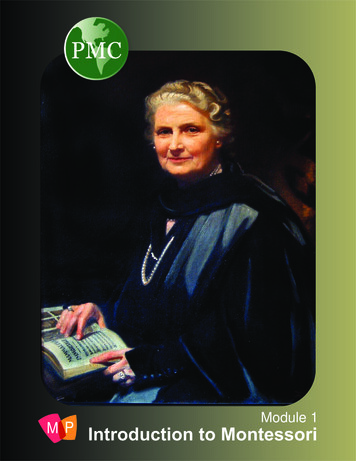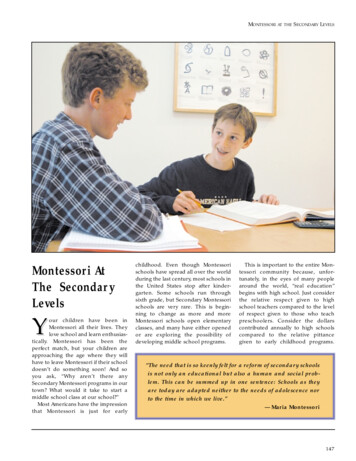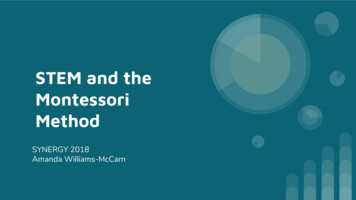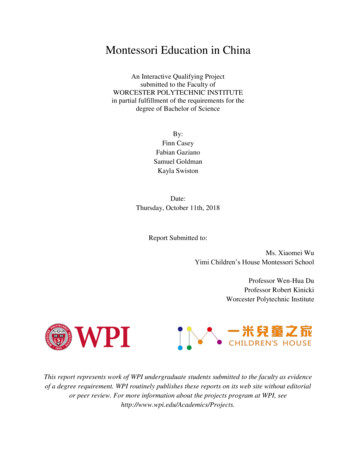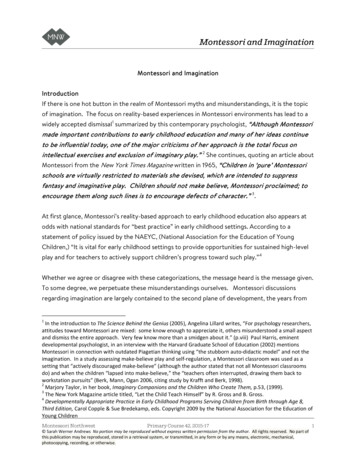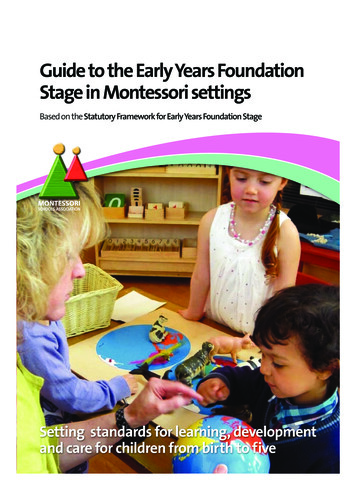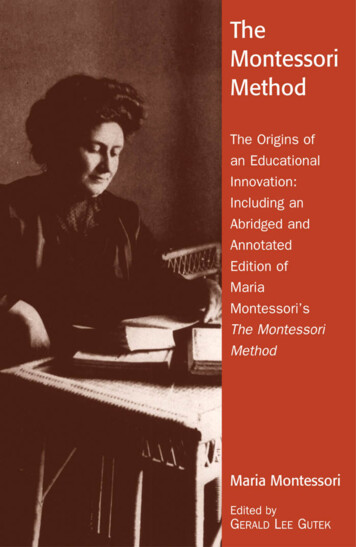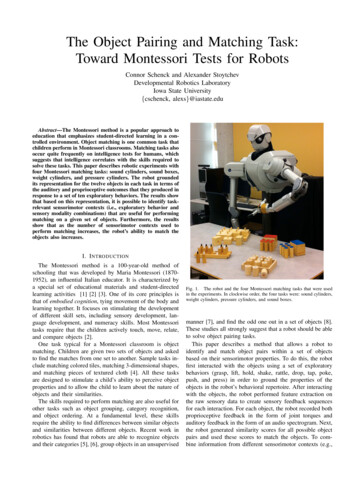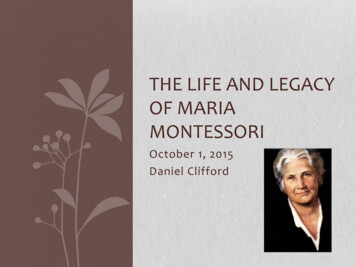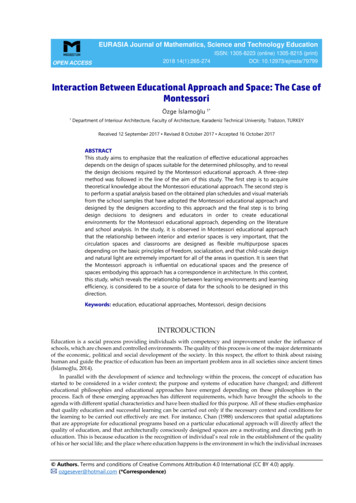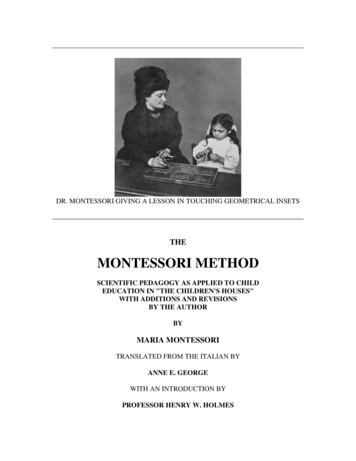
Transcription
DR. MONTESSORI GIVING A LESSON IN TOUCHING GEOMETRICAL INSETSTHEMONTESSORI METHODSCIENTIFIC PEDAGOGY AS APPLIED TO CHILDEDUCATION IN "THE CHILDREN'S HOUSES"WITH ADDITIONS AND REVISIONSBY THE AUTHORBYMARIA MONTESSORITRANSLATED FROM THE ITALIAN BYANNE E. GEORGEWITH AN INTRODUCTION BYPROFESSOR HENRY W. HOLMES
OF HARVARD UNIVERSITYWITH THIRTY-TWO ILLUSTRATIONS FROM PHOTOGRAPHSSECOND EDITIONNEW YORKFREDERICK A. STOKES COMPANYMCMXIICopyright, 1912, byFREDERICK A. STOKES COMPANYAll rights reserved, including that of translation into foreign languages, including theScandinavianFASC April, 1912I place at the beginning of this volume, now appearing in the UnitedStates, her fatherland, the dear name ofALICE HALLGARTENof New York, who by her marriage to Baron Leopold Franchetti becameby choice our compatriot.Ever a firm believer in the principles underlying the Case dei Bambini,she, with her husband, forwarded the publication of this book in Italy, and,throughout the last years of her short life, greatly desired the Englishtranslation which should introduce to the land of her birth the work sonear her heart.To her memory I dedicate this book, whose pages, like an ever-livingflower, perpetuate the recollection of her beneficence.ACKNOWLEDGEMENTS
Grateful acknowledgement is made to Mrs. Guy Barring, of London, forthe loan of her manuscript translation of "Pedagogia Scientifica"; to Mrs.John R. Fisher (Dorothy Canfield) for translating a large part of the newwork written by Dr. Montessori for the American Edition; and to TheHouse of Childhood, Inc., New York, for use of the illustrations of thedidactic apparatus. Dr. Montessori's patent rights in the apparatus arecontrolled, for the United States and Canada, by The House of Childhood,Inc.THE PUBLISHERS.PREFACE TO THE AMERICAN EDITIONIN February, 1911, Professor Henry W. Holmes, of the Division of Education at HarvardUniversity, did me the honour to suggest that an English translation be made of myItalian volume, "Il Metodo della Pedagogia Scientifica applicato all' educazione infantilenelle Case dei Bambini." This suggestion represented one of the greatest events in thehistory of my educational work. To-day, that to which I then looked forward as anunusual privilege has become an accomplished fact.The Italian edition of "Il Metodo della Pedagogia Scientifica" had no preface, becausethe book itself I consider nothing more than the preface to a more comprehensive work,the aim and extent of which it only indicates. For the educational method for childrenfrom three to six years set forth here is but the earnest of a work that, developing thesame principle and method, shall cover in a like manner the successive stages ofeducation. Moreover, the method which obtains in the Casa dei Bambini offers, it seemsto me, an experimental field for the study of man, and promises, perhaps, thedevelopment of a science that shall disclose other secrets of nature.In the period that has elapsed between the publication of the Italian and Americaneditions, I have had, with my pupils, the opportunity to simplify and render more exactcertain practical details of the method, and to gather additional observations concerningdiscipline. The results attest the vitality of the method, and the necessity for an extendedscientific collaboration in the near future, and are embodied in two new chapters writtenfor the American edition. I know that my method has been widely spoken of in America,thanks to Mr. S. S. McClure, who has presented it through the pages of his well-knownmagazine. Indeed, many Americans have already come to Rome for the purpose ofobserving personally the practical application of the method in my little schools. If,encouraged by this movement, I may express a hope for the future, it is that my work inRome shall become the centre of an efficient and helpful collaboration.To the Harvard professors who have made my work known in America and to McClure'sMagazine, a mere acknowledgement of what I owe them is a barren response; but it is my
hope that the method itself, in its effect upon the children of America, may prove anadequate expression of my gratitude.MARIA MONTESSORIROME, TRODUCTIONCHAPTER IA CRITICAL CONSIDERATION OF THE NEW PEDAGOGY IN ITSRELATION TO MODERN SCIENCEInfluence of Modern Science upon PedagogyItaly's part in the development of Scientific PedagogyDifference between scientific technique and the scientific spiritDirection of the preparation should be toward the spirit rather than toward themechanismThe master to study man in the awakening of his intellectual lifeAttitude of the teacher in the light of another exampleThe school must permit the free natural manifestations of the child if in the schoolScientific Pedagogy is to be bornStationary desks and chairs proof that the principle of slavery still informs theschoolConquest of liberty, what the school needsWhat may happen to the spiritPrizes and punishments, the bench of the soulAll human victories, all human progress, stand upon the inner forceCHAPTER IIHISTORY OF METHODSNecessity of establishing the method peculiar to Scientific PedagogyOrigin of educational system in use in the "Children's Houses"Practical application of the methods of Itard and Séguin in the OrthophrenicSchool at Rome14791213151619202124283132
Origin of the methods for the education of deficientsApplication of the methods in Germany and FranceSéguin's first didactic material was spiritualMethods for deficients applied to the education of normal childrenSocial and pedagogical importance of the "Children's Houses"CHAPTER IIIINAUGURAL ADDRESS DELIVERED ON THE OCCASION O F THEOPENING OF ONE OF THE "CHILDREN'S HOUSES"The Quarter of San Lorenzo before and since the establishment of the "Children'sHouses"Evil of subletting the most cruel form of usuryThe problem of life more profound than that of the Intellectual elevation of thepoorIsolation of the masses of the poor, unknown to past centuriesWork of the Roman Association of Good Building and the moral importance oftheir reformsThe "Children's House" earned by the parents through their care of the buildingPedagogical organization of the "Children's House"The "Children's House" the first step toward the socialization of the houseThe communised house in its relation to the home and to the spiritual evolution ofwomenRules and regulations of the "Children's Houses"CHAPTER IVPEDAGOGICAL METHODS USED IN THE "CHILDREN'S HOUSES"Child psychology can be established only through the method of externalobservationAnthropological considerationAnthropological notesEnvironment and schoolroom furnishingsCHAPTER iscipline through libertyIndependenceAbolition of prizes and external forms of punishmentBiological concept of liberty in pedagogyCHAPTER VIHOW THE LESSON SHOULD BE GIVEN8695101104
Characteristics of the individual lessonsMethod of observation the fundamental guideDifference between the scientific and unscientific methods illustratedFirst task of educators to stimulate life, leaving it then free to developCHAPTER VIIEXERCISES OF PRACTICAL LIFESuggested schedule for the "Children's Houses"The child must be prepared for the forms of social life and his attention attractedto these formsCleanlinss, order, poise, conversationCHAPTER VIII107108109115119121122REFECTION–THE CHILD'S DIETDiet must be adapted to the child's physical natureFoods and their preparationDrinksDistribution of mealsCHAPTER IX125126132133MUSCULAR EDUCATION–GYMNASTICSGenerally accepted idea of gymnastics is inadequateThe special gymnastics necessary for little childrenOther pieces of gymnastic apparatusFree gymnasticsEducational gymnasticsRespiratory gymnastics, and labial, dental, and lingual gymnasticsCHAPTER X137138141144144147NATURE IN EDUCATION–AGRICULTURAL LABOUR; CULTURE OFPLANTS AND ANIMALSThe savage of the AveyronItard's educative drama repeated in the education of little childrenGardening and horticulture basis of a method for education of childrenThe child initiated into observation of the phenomena of life and into foresight byway of auto-educationChildren are initiated into the virtue of patience and into confident expectation,and are inspired with a feeling for natureThe child follows the natural way of development of the human race149153155156159160
CHAPTER XIMANUAL LABOUR–THE POTTER'S ART, AND BUILDINGDifference between manual labour and manual gymnasticsThe School of Educative ArtArchæological, historical, and artistic importance of the vaseManufacture of diminutive bricks and construction of diminutive walls and housesCHAPTER XIIEDUCATION OF THE SENSESAim of education to develop the energiesDifference in the reaction between deficient and normal children in thepresentation of didactic material made up of graded stimuliEducation of the senses has as its aim the refinement of the differential perceptionof stimuli by means of repeated exercisesThree periods of SéguinCHAPTER XIIIEDUCATION OF THE SENSES AND ILLUSTRATIONS OF THE DIDACTICMATERIAL: GENERAL SENSIBILITY: THE TACTILE, THERMIC, BARICAND STEREOGNOSTIC SENSESEducation of the tactile, thermic and baric sensesEducation of the stereognostic senseEducation of the senses of taste and smellEducation of the sense of visionExercises with the three series of cardsEducation of the chromatic senseExercise for the discrimination of soundsMusical educationTests for acuteness of hearingA lesson in silenceCHAPTER XIVGENERAL NOTES ON THE EDUCATION OF THE SENSESAim in education biological and socialEducation of the senses makes men observers and prepares them directly forpractical lifeCHAPTER XVINTELLECTUAL EDUCATIONSense exercises a species of 199200203206209212215218224
Importance of an exact nomenclature, and how to teach itSpontaneous progress of the child the greatest triumph of Scientific PedagogyGames of the blindApplication of the visual sense to the observation of environmentMethod of using didactic material: dimensions, form, designFree plastic workGeometric analysis of figuresExercises in the chromatic senseCHAPTER XVIMETHOD FOR THE TEACHING OF READING AND WRITINGSpontaneous development of graphic language: Séguin and ItardNecessity of a special education that shall fit man for objective observation anddirect logical thoughtResults of objective observation and logical thoughtNot necessary to begin teaching writing with vertical strokesSpontaneous drawing of normal childrenUse of Froebel mats in teaching children sewingChildren should be taught how before they are made to execute a taskTwo diverse forms of movement made in writingExperiments made with normal childrenOrigin of alphabets in present useCHAPTER XVIIDESCRIPTION OF THE METHOD AND DIDACTIC MATERIAL USEDExercise tending to develop the muscular mechanism necessary in holding andusing the instrument in writingDidactic material for writingExercise tending to establish the visual-muscular imageof the alphabetic signs,and to establish the muscular memory of the movements necessary to writingExercises for the composition of wordsReading, the interpretation of an idea from written signsGames for the reading of wordsGames for the reading of phrasesPoint education has reached in the "Children's Houses"CHAPTER XVIIILANGUAGE IN CHILDHOODPhysiological importance of graphic languageTwo periods in the development of 261262267269271271275281296299303307310312
Analysis of speech necessaryDefects of language due to educationCHAPTER XIX319322TEACHING OF NUMERATION: INTRODUCTION TO ARITHMETICNumbers as represented by graphic signsExercises for the memory of numbersAddition and subtraction from one to twenty: multiplication and divisionLessons on decimals: arithmetic calculations beyond tenCHAPTER XX328330332335SEQUENCE OF EXERCISESSequence and grades in the presentation of material and in the exercisesFirst gradeSecond gradeThird gradeFourth gradeFifth gradeCHAPTER XXI338338339342343345GENERAL REVIEW OF DISCIPLINEDiscipline better than in ordinary schoolsFirst dawning of discipline comes through workOrderly action is the true rest for muscles intended by nature for actionThe exercise that develops life consists in the repetition, not in the mere grasp ofthe ideaAim of repetition that the child shall refine his senses through the exercise ofattention, of comparison, of judgmentObedience is naturally sacrificeObedience develops will-power and the capacity to perform the act it becomesnecessary to obeyCHAPTER XXIICONCLUSIONS AND IMPRESSIONSThe teacher has become the director of spontaneous work in the "Children'sHouses"The problems of religious education should be solved by positive pedagogySpiritual influence of the "Children's Houses"346350354358360363367371372376
ILLUSTRATIONS.Dr. Montessori giving a lesson in touching geometrical insetsDr. Montessori in the garden of the school at Via GiustiChildren learning to button and lace. Ribbon and button frames.Children playing a game with tablets of coloured silkGirl touching a letter and boy telling objects by weightPupils arranging colours in chromatic orderDidactic apparatus to teach differentiation of objectsBlocks by which children are taught thickness, length, and sizeGeometric insets to teach formGeometric insets and cabinetCards used in teaching form and contourFrames illustrating lacing; shoe buttoning; buttoning of other garments;hooks and eyesTablets with silk, for educating the chromatic senseDidactic apparatus for training the sense of touch, and for teaching writingChildren touching letters and making words with cardboard scriptMontessori children eating dinnerSchool at Tarrytown, N. 5196200201282283348349This book has been put on-line as part of the BUILD-A-BOOK Initiative at theCelebration of Women Writers through the combined work of: Ann and Neil Piche, AnnaHaynes, Elizabeth Morton, Carmen Baxter, Inez Gowsell, Ingrid Olsson, Jessie Hudgins,Jim Fritzler, Joe Johnson, John Phelan, Judith A. Fetterolf, Kate D'Amico, Leslee Suttie,Lou Anne Meloche, Mary Nuzzo, Nick Rezmerski, Shirley Boyle, and Mary MarkOckerbloom."Introduction." by Henry W. HolmesFrom: The Montessori Method essori/method/method.html] by MariaMontessori, translated by Anne Everett George. New York: Frederick A. StokesCompany, 1912.INTRODUCTIONAN audience already thoroughly interested awaits this translation of a remarkable book.For years no educational document has been so eagerly expected by so large a public, andnot many have better merited general anticipation. That this widespread interest exists isdue to the enthusiastic and ingenious articles in McClure's Magazine for May and
December, 1911, and January, 1912; but before the first of these articles appeared anumber of English and American teachers had given careful study to Dr. Montessori'swork, and had found it novel and important. The astonishing welcome accorded to thefirst popular expositions of the Montessori system may mean much or little for its futurein England and America; it is rather the earlier approval of a few trained teachers andprofessional students that commends it to the educational workers who must ultimatelydecide upon its value, interpret its technicalities to the country at large, and adapt it toEnglish and American conditions. To them as well as to the general public this briefcritical Introduction is addressed.It is wholly within the bounds of safe judgment to call Dr. Montessori's work remarkable,novel, and important. It is remarkable, if for no other reason, because it represents theconstructive effort of a woman. We have no other example of an educational system–original at least in its systematic wholeness and in its practical application–worked outand inaugurated by the feminine mind and hand. It is remarkable, also, because it springsfrom a combination of womanly sympathy and intuition, broad social outlook, scientifictraining, intensive and long-continued study of educational problems, and, to crown all,varied and unusual experience as a teacher and educational leader. No other woman whohas dealt with Dr. Montessori's problem–the education of young children–has brought toit personal resources so richly diverse as hers. These resources, furthermore, she hasdevoted to her work with an enthusiasm, an absolute abandon, like that of Pestalozzi andFroebel, and she presents her convictions with an apostolic ardour which commandsattention. A system which embodies such a capital of human effort could not beunimportant. Then, too, certain aspects of the system are in themselves striking andsignificant: it adapts to the education of normal children methods and apparatus originallyused for deficients; it is based on a radical conception of liberty for the pupil; it entails ahighly formal training of separate sensory, motor, and mental capacities; and it leads torapid, easy, and substantial mastery of the elements of reading, writing, and arithmetic.All this will be apparent to the most casual reader of this book.None of these things, to be sure, is absolutely new in the educational world. All havebeen proposed in theory; some have been put more or less completely into practice. It isnot unjust, for instance, to point out that much of the material used by Dr. Walter S.Fernald, Superintendent of the Massachusetts Institution for the Feeble-Minded atWaverly, is almost identical with the Montessori material, and that Dr. Fernald has longmaintained that it could be used to good effect in the education of normal children. (Itmay interest American readers to know that Séguin, on whose work that of Dr.Montessori is based, was once head of the school at Waverly.) So, too, formal training invarious psycho-physical processes has been much urged of late by a good many workersin experimental pedagogy, especially by Meumann. But before Montessori, no one hadproduced a system in which the elements named above were combined. She conceived it,elaborated it in practice, and established it in schools. It is indeed the final result, as Dr.Montessori proudly asserts, of years of experimental effort both on her own part and onthe part of her great predecessors; but the crystallisation of these experiments in aprogramme of education for normal children is due to Dr. Montessori alone. Theincidental features which she has frankly taken over from other modern educators she has
chosen because they fit into the fundamental form of her own scheme, and she hasunified them all in her general conception of method. The system is not original in thesense in which Froebel's system was original; but as a system it is the novel product of asingle woman's creative genius.As such, no student of elementary education ought to ignore it. The system doubtless failsto solve all the problems in the education of young children; possibly some of thesolutions it proposes are partly or completely mistaken; some are probably unavailable inEnglish and American schools; but a system of education does not have to attainperfection in order to merit study, investigation, and experimental use. Dr. Montessori istoo large-minded to claim infallibility, and too thoroughly scientific in her attitude toobject to careful scrutiny of her scheme and the thorough testing of its results. Sheexpressly states that it is not yet complete. Practically, it is highly probable that thesystem ultimately adopted in our schools will combine elements of the Montessoriprogramme with elements of the kindergarten programme, both "liberal" and"conservative." In its actual procedure school work must always be thus eclectic. An allor-nothing policy for a single system inevitably courts defeat; for the public is notinterested in systems as systems, and refuses in the end to believe that any one systemcontains every good thing. Nor can we doubt that this attitude is essentially sound. If wecontinue, despite the pragmatists, to believe in absolute principles, we may yet remainskeptical about the logic of their reduction to practice–at least in any fixed programme ofeducation. We are not yet justified, at any rate, in adopting one programme to theexclusion of every other simply because it is based on the most intelligible or the mostinspiring philosophy. The pragmatic test must also be applied, and rigorously. We musttry out several combinations, watch and record the results, compare them, and proceedcautiously to new experiments. This procedure is desirable for every stage and grade ofeducation, but especially for the earliest stage, because there it has been least attemptedand is most difficult. Certainly a system so radical, so clearly defined, and so welldeveloped as that of Dr. Montessori offers for the thoroughgoing comparative study ofmethods in early education new material of exceptional importance. Without acceptingevery detail of the system, without even accepting unqualifiedly its fundamentalprinciples, one may welcome it, thus, as of great and immediate value. If early educationis worth studying at all, the educator who devotes his attention to it will find it necessaryto define the differences in principle between the Montessori programme and otherprogrammes, and to carry out careful tests of the results obtainable from the varioussystems and their feasible combinations. One such combination this Introduction willsuggest, and it will discuss also the possible uses of the Montessori apparatus in thehome; but it may be helpful first to present the outstanding characteristics of theMontessori system as compared with the modern kindergarten in its two main forms.Certain similarities in principle are soon apparent. Dr. Montessori's views of childhoodare in some respects identical with those of Froebel, although in general decidedly moreradical. Both defend the child's right to be active, to explore his environment and develophis own inner resources through every form of investigation and creative effort.Education is to guide activity, not repress it. Environment cannot create human power,but only give it scope and material, direct it, or at most but call it forth; and the teacher's
task is first to nourish and assist, to watch, encourage, guide, induce, rather than tointerfere, prescribe, or restrict. To most American teachers and to all kindergartners thisprinciple has long been familiar; they will but welcome now a new and eloquentstatement of it from a modern viewpoint. In the practical interpretation of the principle,however, there is decided divergence between the Montessori school and thekindergarten. The Montessori "directress" does not teach children in groups, with thepractical requirement, no matter how well "mediated," that each member of the groupshall join in the exercise. The Montessori pupil does about as he pleases, so long as hedoes not do any harm.Montessori and Froebel stand in agreement also on the need for training of the senses; butMontessori's scheme for this training is at once more elaborate and more direct thanFroebel's. She has devised out of Séguin's apparatus a comprehensive and scientificscheme for formal gymnastic of the senses; Froebel originated a series of objectsdesigned for a much broader and more creative use by the children, but by no means soclosely adapted to the training of sensory discrimination. The Montessori material carriesout the fundamental principle of Pestalozzi, which he tried in vain to embody in asuccessful system of his own: it "develops piece by piece the pupil's mental capacities"by training separately, through repeated exercises, his several senses and his ability todistinguish, compare, and handle typical objects. In the kindergarten system, andparticularly in the "liberal" modifications of it, sense training is incidental to constructiveand imaginative activity in which the children are pursuing larger ends than the merearrangement of forms or colours. Even in the most formal work in kindergarten designthe children are "making a picture," and are encouraged to tell what it looks like–"a star,""a kite," "a flower."As to physical education, the two systems agree in much the same way: both affirm theneed for free bodily activity, for rhythmic exercises, and for the development of muscularcontrol; but whereas the kindergarten seeks much of all this through group games with animaginative or social content, the Montessori scheme places the emphasis on specialexercises designed to give formal training in separate physical functions.In another general aspect, however, the agreement between the two systems, strong inprinciple, leaves the Montessori system less formal rather than more formal in practice.The principle in this case consists of the affirmation of the child's need for social training.In the conservative kindergarten this training is sought once more, largely in groupgames. These are usually imaginative, and sometimes decidedly symbolic: that is, thechildren play at being farmers, millers, shoemakers, mothers and fathers, birds, animals,knights, or soldiers; they sing songs, go through certain semi-dramatic activities–such as"opening the pigeon house," "mowing the grass," "showing the good child to theknights," and the like; and each takes his part in the representation of some typical socialsituation. The social training involved in these games is formal only in the sense that thechildren are not engaged, as the Montessori children often are, in a real social enterprise,such as that of serving dinner, cleaning the room, caring for animals, building a toyhouse, or making a garden. It cannot be too strongly emphasized that even the mostconservative kindergarten does not, on principle, exclude "real" enterprises of this latter
sort; but in a three-hour session it does rather little with them. Liberal kindergartners domore, particularly in Europe, where the session is often longer. Nor does the Montessorisystem wholly exclude imaginative group games. But Dr. Montessori, despite anevidently profound interest not only in social training, but also in aesthetic, idealistic, andeven religious development, speaks of "games and foolish stories" in a casual andderogatory way, which shows that she is as yet unfamiliar with the Americankindergartner's remarkable skill and power in the use of these resources. (Of course theAmerican kindergartner does not use "foolish" stories; but stories she does use, and togood effect.) The Montessori programme involves much direct social experience, both inthe general life of the school and in the manual work done by the pupils; the kindergartenextends the range of the child's social consciousness through the imagination. Thegroupings of the Montessori children are largely free and unregulated; the groupings ofkindergarten children are more often formal and prescribed.On one point the Montessori system agrees with the conservative kindergarten, but notwith the liberal: it prepares directly for the mastery of the school arts. There can be nodoubt that Dr. Montessori has devised a peculiarly successful scheme for teachingchildren to write, an effective method for the introduction of reading, and good materialfor early number work. Both types of kindergarten increase, to be sure, the child's generalcapacity for expression: kindergarten activity adds to his stock of ideas, awakens andguides his imagination, increases his vocabulary, and trains him in the effective use of it.Children in a good kindergarten hear stories and tell them, recount their own experiences,sing songs, and recite verses, all in a company of friendly but fairly critical listeners,which does even more to stimulate and guide expression than does the circle at home. Buteven the conservative kindergarten does not teach children to write and to read. It doesteach them a good deal about number; and it may fairly be questioned whether it does notdo more fundamental work in this field than the Montessori system itself. The Froebeliangifts offer exceptional opportunity for concrete illustration of the conceptions of wholeand part, through the creation of wholes from parts, and the breaking up of wholes intoparts. This aspect of number is at least as important as the series aspect, which childrenget in counting and for which the Montessori "Long Stair" provides such good material.The Froebelian material may be used very readily for counting, however, and theMontessori material gives some slight opportunity for uniting and dividing. So far aspreparation for arithmetic is concerned, a combination of the two bodies of material isboth feasible and desirable. The liberal kindergarten, meanwhile, abandoning the use ofthe gifts and occupations for mathematical purposes, makes no attempt to prepare itspupils directly for the school arts.Compared with the kindergarten, then, the Montessori system presents these main pointsof interest: it carries out far more radically the principle of unrestricted liberty; itsmaterials are intended for the direct and formal training of the senses; it includesapparatus designed to aid in the purely physical development of the children; its socialtraining is carried out mainly by means of present and actual social activities; and itaffords direct preparation for the school arts. The kindergarten, on the other hand,involves a certain amount of group-teaching, in which children are held–not necessarilyby the enforcement of authority, yet by authority, confessedly, when other means fail–to
definite activities; its materials are intended primarily for creative use by the children andoffer opportunity for mathematical analysis and the teaching of design; and its procedureis rich in resources for the imagination. One thing should be made entirely clear andemphatic: in none of these characteristics are the two systems ri
montessori method scientific pedagogy as applied to child education in "the children's houses" with additions and revisions by the author by maria montessori translated from the italian by anne e. george with an introduction by professor henry w. holmes . of harvard universityFile Size: 2MB
